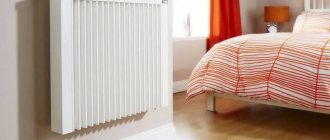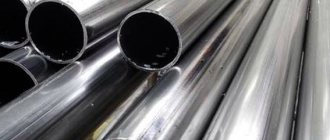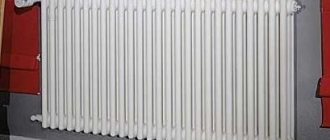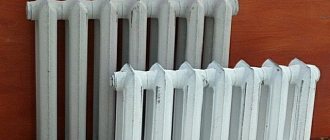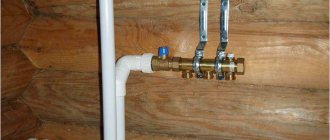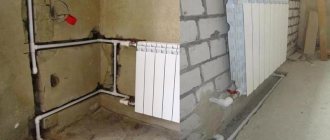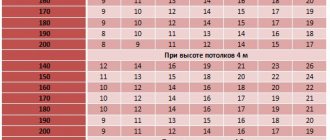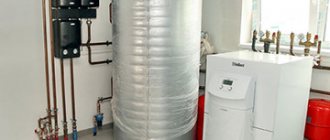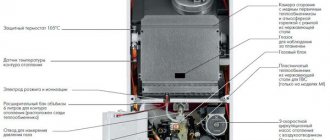Heating system compatibility
Heating radiators
Today, the market offers a very diverse range of batteries, and when purchasing, it is important to understand which radiators (cast iron, steel, aluminum, copper, bimetallic) will be more “appropriate” for your heating system.
To do this, you need to compare the technical characteristics of the heating battery and the parameters of your heating system. An important factor, of course, is the appearance of the radiator, as well as its price. It is also necessary to take into account that apartment buildings (open heating systems) and private households (closed) have their own requirements for heating radiators.
Incorrect selection of a radiator leads to rapid wear and tear and even failure of the system.
Aluminum
Aluminum heating radiators are made not from pure aluminum, but from an alloy based on it. This metal was not chosen by chance, as it has one of the highest heat transfer coefficients - 4-4.5 times better than cast iron and 5 times better than steel.
Table with thermal conductivity coefficients of different metals
That is why aluminum radiators are distinguished by their high power (180-190 W per section), no less high heating rate and low inertia. They work very effectively in tandem with thermostats, allowing you to maintain a stable temperature with an accuracy of one degree. The advantages of aluminum radiators include their low weight (one section weighs 1.5-2 kilograms), which makes delivery and installation easier. Another positive point is that the shape is designed so that it has a large cross-section of channels for the coolant (slightly smaller than that of cast iron “accordions”). This is good, since there is a low probability that these channels will become clogged and the radiator will stop heating.
Now about the disadvantages of aluminum radiators. They are related to the properties of aluminum. As you know, it is a chemically active metal. It actively interacts with most of the chemical table, and reacts especially violently with copper. And in modern heating systems, copper parts are often found. Such a proximity threatens the rapid release of copper parts of the system and system, as well as increased gas formation. They have learned to deal with gases - they install automatic gas vents (valves) in systems, and they save copper by not placing it close to aluminum appliances. The process, of course, is still going on, but not with such intensity.
Aluminum radiators look modern
The chemical activity of aluminum also manifests itself in demands on the quality of the coolant. Not in the sense of its contamination, but in the sense of its acidity. Aluminum radiators work normally in systems with coolant acidity no higher than 7 (Ph 7).
The softness of aluminum is also not very good for the operation of the heating system. The alloy from which heating radiators are made contains additives that increase its hardness, but still, they do not work in high-pressure networks. Typical operating pressure is 8-16 atm depending on the type and manufacturer.
Based on all of the above, there appears to be an area in which aluminum radiators will be the best. These are individual heating systems with boilers controlled by automation. They also do well in apartments, but only in small buildings (up to 10 floors), in which coolant with Ph 7-8 circulates.
How to buy a heating radiator that meets the technical parameters of the heating system?
When choosing a radiator, its technical and operational characteristics should be in the foreground, and only then you should pay attention to the price and appearance.
Let's be honest, domestic heating networks are a test for any heating battery. Fluctuations in temperature, pressure, terrible quality of water (coolant) - with such “gifts” the service life and quality of operation of the radiator are reduced.
For example, for domestic heating systems in multi-storey buildings, the calculated coolant temperature is 105°C and the pressure is 10 Atm. When starting heating at the beginning of the heating season, sometimes it turns out that these parameters go off scale. The result is a water hammer, which often simply “tears” some radiators (especially imported ones).
Therefore, when choosing a radiator, you need to carefully clarify the permissible limits of coolant temperatures and pressure in the system with which this battery is capable of working.
One of the most important parameters for a heating radiator is its heat transfer, which directly affects the efficiency of heating the room.
Heat dissipation is determined by the material from which the battery is made. Steel radiators, for example, have lower heat transfer than aluminum ones, and copper radiators are better than cast iron ones in this regard.
However, in order to buy a heating radiator “correctly”, it is not enough to simply choose a battery with the best heat transfer. You need to take a comprehensive approach and evaluate all possible nuances specifically for your apartment or house.
Radiators for installation in an apartment
The choice of heating devices for an apartment is complicated by the fact that they are connected to a centralized system. It is its features that impose certain restrictions on the use of some models.
Specifics of central heating
To decide which heating radiators are best installed in an apartment, you need to take into account the advantages and disadvantages of connecting to the city heating network. On the one hand, it is more convenient than an individual heating system, since it eliminates the need to independently heat the room. At the same time, hot water running through pipes from the central boiler room brings not only convenience, but also creates certain difficulties:
- it contains many aggressive impurities that cause metal corrosion, as well as small rock particles that damage internal surfaces;
- the coolant temperature can vary greatly over short periods of time;
- the likelihood of water hammer occurring is too high - sudden and strong pressure surges inside the system, from which the batteries are damaged, and the hot water from them splashes around the room or, at best, begins to leak.
Taking into account these weak points, heating devices connected to the centralized heating network must meet the following requirements:
- the product parameters must indicate the ability to withstand high pressure and resist water hammer;
- the internal surface must be chemically neutral or have a special protective coating.
In addition, it is recommended to choose devices with excellent thermal conductivity and high quality workmanship, which will ensure their long-term operation.
Suitable Battery Types
Not all types of devices meet the specified characteristics. Each metal from which they are made has its own characteristics:
- Aluminum heating radiators. Attractive in appearance, lightweight, with excellent heat transfer. But the presence of aggressive impurities and excessive acidity of water leads to the rapid destruction of aluminum, which is characterized by increased chemical activity. In addition, it will not withstand water hammer either (the maximum pressure level is 16 atmospheres).
- Steel. Compact, highly efficient, dissipates heat well. But they can withstand even less pressure than aluminum ones (no more than 8–13 atmospheres).
- Bimetallic. The best in all respects. Bimetallic central heating radiators are optimal for apartments. They can operate at elevated temperatures (up to 130⁰C) and a pressure of 30 atmospheres (some up to 50), and also have an anti-corrosion coating, light weight and increased decorativeness. There is only one drawback - the high price.
- Cast iron. The second devices are suitable for residential installation and are not afraid of contaminated water with aggressive additives. Cast iron retains heat better and longer than all other metals, stoically withstands water hammer, and emits infrared rays, which are considered the most useful type of thermal radiation.
Bimetallic heating radiators
Cast iron heating radiators
Steel heating radiators
Steel tubular heating radiators
Aluminum heating radiators
Thus, models made of steel and aluminum are not suitable for connection to centralized heating networks. The best choice for an apartment would be Russian or imported bimetallic and cast iron heating radiators from trusted manufacturers.
Best models
The best bimetallic products for apartments are:
- Rifar Monolit are Russian-made devices designed for use in critical conditions. Maintain performance characteristics at 135⁰С and are not afraid of water hammer.
- Royal Thermo BiLiner - made in an ideal streamlined shape, have an even number of sections, not exceeding 12 pieces. Manifold made of steel, modernized. The outside is coated with a unique composition that provides increased resistance to mechanical and chemical influences.
- Global STYLE PLUS - characterized by resistance to acidic environments, covered with a protective layer of zirconium fluoride, external surfaces are painted with white enamel, giving them a respectable appearance. They comply with Russian GOST standards and have a certificate for the territory of the Russian Federation.
- Sira RS - made in a shape with rounded corners, have enhanced strength and resistance to chemical impurities, and are not afraid of sudden temperature changes. Optimally meets the conditions of heat exchange by convection.
The best cast iron batteries for an apartment are:
- KONNER Modem is a domestic product that is optimally suited for installation in Russian apartments. Easy to install, very reliable, transfer heat well, and are not subject to mechanical damage and corrosion.
- MS-140 are Belarusian-made batteries, adapted for use in heating networks with low water quality and frequent temperature and pressure surges. They have anti-corrosion resistance.
Radiator Sira RS
Radiator Royal Thermo Biliner
Radiator Rifar Monolit
Radiator Global Style Plus
Cast iron sectional radiator Modern 300
Cast iron radiator MC-140
In addition to the models described, it is recommended to pay attention to products from manufacturers that are recognized as the best in the rating described below.
Sectional heating radiators
This is the most popular type of design, which allows you to assemble a heating radiator of the required power from separate sections. Each section has a limit on the thermal power it can provide (under certain conditions). It is this characteristic that is taken into account when calculating the heating system. The materials from which sectional radiators are made have their own advantages (and disadvantages) and to some extent limit the scope of application for an apartment or private house.
Cast iron radiators
1. Cast iron radiators. We can say that cast iron is a classic material for heating radiators, which is most popular for apartments. Cast iron batteries work especially well in old central heating systems with low quality coolant. The large volume of internal cavities protects the battery from blockages even in extreme conditions, including during frequent line accidents and repair work, when dirt and scale from welding gets into the pipes. Among ferrous metals, cast iron is the most resistant to corrosion - this is another plus, especially for systems in which the coolant is drained in the off-season. High heat capacity determines the same high inertia - this limits the accuracy and efficiency of automatic temperature control. Therefore, the use of cast iron batteries in an autonomous heating system makes no sense. The disadvantages include low decorative qualities (for example, the MS-140 model) and the need to periodically update the paintwork. Although retro-style batteries are cast from cast iron, the cost of which is one of the highest among all types.
Aluminum radiators
2. Aluminum radiators. This type is ideal for heating a private home with guaranteed coolant quality and good pipe condition. Low thermal inertia and high thermal conductivity allow them to be used in systems with automatic temperature control. And the design fits well into modern interiors. But in old apartment buildings, the use of aluminum batteries is not recommended. In addition to sensitivity to the quality of the coolant and the condition of the pipelines, there are also problems with stray currents, especially in houses with TN-C type electrical networks. In addition, aluminum radiators may not withstand hydrodynamic shocks during pressure surges (for example, during pre-season preparation of the heating system). Thermal inertness is the ability of materials or environments to absorb heat and retain it as they heat up. If the ambient temperature decreases, the accumulated heat enters the environment, and the materials or environment themselves are cooled. But it takes some time to cool or warm up to the changed ambient temperature.
Bimetallic radiators
3. Bimetallic radiators. There are two types of metal pairs: steel and aluminum, steel and copper. The design may also differ - the liner may be entirely or partially steel. The lower price of a steel-aluminum radiator explains its popularity, although properties such as thermal conductivity and durability are higher in copper. In terms of strength, bimetallic radiators are the best among other sectional batteries. They “hold” the operating pressure of the system better than cast iron ones. The only drawback that limits the scope of application is the small internal cross-section. Therefore, the heating system must maintain a high coolant flow rate. This condition is critical for heating systems in a private home.
Overview of different types
Before purchasing equipment that is so valuable for a comfortable life, you should analyze all the properties of radiators made of different materials and understand which ones are best to choose for heating your private home.
Real “veterans” of the market. They are characterized by high performance, impressive durability and resistance to various types of loads. They have proven themselves when used in systems with high operating pressures - on average up to 10 bar.
The sections of such batteries have a fairly large volume and thick walls, which guarantees fairly highly efficient heating. The service life of cast iron appliances in most cases significantly exceeds 50 years.
The heat transfer rates of 1 section of the device can fluctuate on average from 100 to 200 W. The specific value is determined by the standard size of the compartment. You can see the comparative characteristics of cast iron and bimetallic radiators in this article.
In general, cast iron batteries, known for their almost absolute resistance to contact with low-quality coolants, are very popular among domestic consumers - this is due to the characteristics of their operation.
Radiators made from this material have proven themselves in private housing construction. The design features and raw materials are such that the finished product weighs much less compared to the previously discussed cast iron analogue and has less thick walls, which ensures faster heating of the unit.
Modern steel batteries can be used in systems with operating pressures of up to 10 atm and temperatures of no more than +150 degrees. Models with horizontal and vertical channels are available for sale.
Additional advantages of such devices include a wide range of design solutions - batteries from the factory can have a variety of colors, which allows them to fit seamlessly into any interior.
Aluminum
Aluminum products compare favorably with their “brothers” in their light weight, elegance and high heat transfer rates. Such products combine 2 mechanisms of heat transfer: through convection and radiation, which makes them the most effective devices for heating residential premises. At the same time, the permissible operating pressure in the system is also impressive - up to 18 atm.
Aluminum is characterized by high heat transfer, which allows for the most efficient heating. In general, when using aluminum batteries, there is approximately 20-30% savings in thermal resource consumption compared to devices made from other materials.
Bimetallic
The products are manufactured using simultaneous use of high-strength steel (internal manifold) and aluminum (external part of the product). In terms of operating pressure, bimetallic batteries are significantly superior to previously considered options - up to 35 atm.
The combined use of aluminum and steel in the design of devices has significantly increased their resistance to contact with coolant, as well as strength, resistance to corrosion damage, and heat transfer performance. At the same time, the units have relatively compact dimensions and a generally neat appearance.
Bimetallic heating radiators are characterized by relative ease of installation and are equally well combined with centralized and autonomous heating systems. How to calculate how many radiator sections you need, see here.
The design of the device is represented by a seamless copper pipe. Other metals are not used in the manufacture of such units. The diameter of the pipe is about 2.8 cm. Additionally, there are copper ribs and a decorative casing, usually made of solid wood.
In terms of thermal conductivity, copper exceeds aluminum by about 2 times, and cast iron and steel by an average of 5-6 times. Combined with low inertia, the radiator provides quick and effective heating of the room being served.
The battery capacity holds a little water, thanks to which the unit warms up within 3-5 minutes. This property is especially relevant for autonomous heating systems - this eliminates the need for constant heating and “running” large volumes of coolant through the pipeline, as, for example, in the case of cast iron batteries.
Copper is resistant to corrosion. performs well when working in combination with a low-temperature coolant, is characterized by high ductility and resistance to aggressive environments.
Panel radiators
Panel radiators
Structurally, a panel heating radiator consists of two profiled steel plates connected by welding.
The combination of a large internal cross-section, high heat transfer and low inertia allows us to speak about the acquisition of the best performance qualities of cast iron and bimetallic radiators. That is, panel radiators in water heating systems can operate at low coolant velocities (for example, in a gravity heating system) and quite accurately respond to the signal from the automation when adjusting the temperature.
But it is the material and production technology that limit the scope of application of panel radiators. Welds do not withstand high pressure well enough and can fail under the influence of corrosion and water hammer. Therefore, they are usually used in heating systems of a private home, with low pressure and controlled quality of the coolant.
Plastic radiators
At the moment, heating radiators are made entirely of plastic, a kind of know-how. Russian engineers in Skolkovo are also working on this type of heater. Contrary to popular belief, in terms of reliability, plastic radiators are close to metal products, and in terms of corrosion resistance, they have no equal. Products made from thermoplastics have high mechanical strength, good thermal conductivity and wear resistance. Plastic radiators are not very heavy, so they are easy to transport and install.
Plastic radiator diagram
For those who doubt the thermophysical properties of plastic, we recommend that you remember the contours of water-heated floors made of cross-linked polypropylene. Its thermal conductivity is lower than that of rigid thermoplastics, and, nevertheless, this does not prevent the use of plastic pipes to build reliable and efficient underfloor heating systems.
Simplicity of manufacture and, as a result, low cost make thermoplastic batteries an excellent offer for those who have set themselves the task of saving money. A significant disadvantage of plastic heat exchangers is that they can only be used in systems with a stable pressure of up to 3 atm and a coolant temperature not higher than 80 °C. For this reason, the promotion of plastic batteries in our market is difficult.
Tubular radiators
Tubular radiators
This type is also called column radiators. The most efficient type in terms of heat transfer is two steel collectors connected by pipes (columns). The simplest type is familiar to many from the design of a heated towel rail for bathrooms. Higher wall thickness and fewer welds give certain advantages to column batteries compared to panel batteries.
Plate water heating radiators are also distinguished separately. But in principle, this type of tubular structure, on the collectors of which plates are installed, is more often called a water convector; the increased contact area with the air flow leads to the fact that the main part of the thermal energy comes not from radiation (radiation), but from convection.
Electric radiators
In addition to the heating devices discussed above, there are others - those that do not require connection to the heating system. You probably already guessed that we are talking about electric radiators.
Modern electric radiators combine high efficiency, reliability and safety.
Depending on the design, there are several types of heat exchangers operating from the electrical network:
- oil radiators;
- convectors;
- infrared devices.
The design of the oil radiator most closely resembles a traditional heating battery. Mineral oil is used as a coolant, and heating is carried out by a tubular electric heater (TEH). The closed design contributes to fire safety and mobility of the device, and the oil heater does not burn oxygen and dust. The disadvantages include bulkiness, low efficiency and the possibility of getting burned when touching a metal surface.
Oil radiators differ from traditional heating batteries in their mobility - if necessary, they can be easily moved from place to place
Electric convectors also use heating due to ohmic losses, only their design uses an air heating element rather than a liquid one. Thanks to their closed design, heaters of this type have the same advantages as oil radiators. As for the design, it is optimized so that the device uses convection as efficiently as possible. The only disadvantage of a convector is low mobility - most often such devices are intended for stationary use.
Simple design and heat transfer by convection contribute to the reliability and efficiency of electric convectors
Infrared radiators are the most modern type of heating equipment. Unlike any other equipment, their design is based on the principle of heat transfer by radiation.
The principle of operation of infrared radiators is borrowed from the Sun - it is not the air in the room that is heated, but reflective objects
By heating not the air, but the surrounding objects, IR heaters are highly efficient and at the same time have the highest efficiency. The only disadvantages of devices that operate similarly to the Sun are their relatively high cost.
Unlike other radiators, infrared devices work most effectively on the ceiling - in this case, the radiation penetrates into the most remote corners of the room
Copper radiators
The only drawback of a copper radiator is its price. Copper is a fairly expensive metal, so installing heating systems using copper batteries will not be affordable for everyone.
Otherwise, copper radiators are full of advantages:
- Heat transfer is twice as high as aluminum, and 5-6 times higher than steel or cast iron.
- A small volume of coolant ensures heating of the battery in 3-4 minutes. For individual heating, this provides significant savings.
- Copper radiators have low inertia, which allows the use of thermostats.
- Copper has the greatest corrosion resistance. Thanks to the oxide layer that forms on the inner surface of the copper battery already in the first few days of operation, the radiator is reliably protected from chemical and even mechanical damage by the coolant.
Copper radiators are made from seamless pipes supplemented with plate fins. Decorative casings made of wood or aluminum make their design even more expressive.
Bimetallic radiators
A bimetallic radiator combines the high strength and durability of a steel heating register and the excellent thermal performance of aluminum convectors.
Bimetallic radiators are indistinguishable from aluminum devices, but have higher reliability and durability
The internal channels of the device are welded from seamless steel pipes, thanks to which the battery can withstand pressure of more than 50 atmospheres and has excellent corrosion resistance. An aluminum casing with convection ribs is fused onto this frame. As a result of this trick, it is possible to obtain a product with maximum heat transfer, low thermal inertia and a service life of up to 25 years.
Technical characteristics of popular bimetallic radiators. The table is available in large size by clicking.
In addition to the monolithic bimetallic radiators described above, the industry produces aluminum-steel heat exchangers assembled from separate sections. A composite battery is inferior to a non-divided design in terms of reliability and durability, but it has advantages in the form of flexible adjustment of thermal power. All you need to do is add or remove a few additional sections. In addition, the undeniable advantage of stacked bimetallic batteries is their high maintainability.
STOUT Space bimetallic radiators combine ease of installation, no-frills aesthetics and a reliable design that can withstand pressures of more than 100 atmospheres. The products are manufactured in the largest Russian one and comply with GOST 31311-2005 “Heating devices”. The maximum coolant temperature is 135°C, the manufacturer’s warranty is 10 years, the service life is 25 years. The available number of sections is from 4 to 14: bimetallic radiators can be installed both in a small kitchen and in the living room of a private house.
Bimetallic heating radiator STOUT in section. A steel heat exchange circuit and aluminum fins make the bimetallic radiator as durable and efficient as possible
The available number of sections is from 4 to 14: bimetallic radiators can be installed both in a small kitchen and in the living room of a private house.
Bimetal heating radiator STOUT for 8 sections
When making your choice in favor of the most technologically advanced of all existing radiators, do not be deceived. In order to save materials and reduce the price of the final product, manufacturers resort to tricks. In some models, steel pipes do not make a monolithic circuit, but only vertical radiator channels. As for the horizontal working cavities, they are cast simultaneously with the aluminum body.
In so-called “semi-bimetallic” batteries, steel plays a reinforcing role and does not have a positive effect on service life. It is very easy to recognize the Light version - just “ring” individual parts of the heating device with a magnet.
In semi-bimetallic radiators, only vertical channels are made of steel, so in terms of reliability and durability they do not differ from aluminum ones.
Technical characteristics of heating radiators
Table with technical characteristics of heating radiators
The range of heating radiators today allows you to take an individual approach to the configuration of any heating system. Experts recommend paying attention, first of all, to the technical characteristics and recommended operating conditions of the radiator.
Cast iron radiators
Cast iron radiators have been used in residential heating systems for more than 100 years and, so far, no type of heating device has surpassed them in corrosion resistance and durability. Possessing high heat transfer, cast iron “accordions” are perfectly suited for use in the vast expanses of the former CIS.
If there is an emergency shutdown of the heating supply, the “cast iron” will retain the accumulated heat for a long time and continue to heat the air. It is not afraid of critical pressure drops, water hammer and poor quality coolant. Hard alkaline water with air pockets and rust particles does not have such a destructive effect on cast iron batteries as on other heating devices, and their price is much lower. All the mentioned advantages still encourage many of our fellow citizens to purchase these radiators as heating devices.
Disadvantages include inexpressive design, bulkiness and high inertia, due to which they cannot be used in modern heating systems with thermoregulation. But in the modern interpretation, heating devices have become more stylish and attractive, while retaining amazing strength and durability.
Unlike the bulky "accordions" of the Soviet era, modern cast iron radiators are a model of design and style. As for exclusive models, many of them can be considered works of art.
Having familiarized yourself with the technical characteristics and other features of modern cast iron radiators, you will no longer be able to throw them off the scale when choosing.
Summary table of cast iron radiators
The average service life is 35-40 years, but in reality, many radiators have been in operation since the 50s of the last century. When citing the disadvantages of heating appliances made of cast iron, everyone remembers bulkiness and heavy weight, completely forgetting about the high thermal inertia. But the last factor is very important, given the general trend towards saving heat, and, as a consequence, the use of thermostatic flow regulators in heating circuits.
Even the most high-tech thermostat will not be able to work in conjunction with a cast iron radiator - this is due to the high thermal inertia of the heating device
Steel types of heating radiators
Steel panel batteries have good heat dissipation and heat up and cool down quickly. To maintain a constant temperature in the room, it is necessary to monitor the regular supply of coolant. However, this type of heating battery allows the use of heating temperature regulators for radiators.
Since they have low inertia and quickly respond to the temperature of the water in the system, it becomes possible to control the heating of the room using thermostats. Depending on the settings, the radiator will heat up or cool down. It is thanks to this quality that steel batteries are becoming increasingly popular.
Their main disadvantage is their susceptibility to corrosion, and the durability of the devices depends on the amount of oxygen dissolved in the water.
It is for this reason that steel radiators are used exclusively in closed heating systems in which contact of the coolant with air is excluded - they are usually created in private homes. The susceptibility to corrosion increases if water is drained from the system, so it is unacceptable to leave heating devices empty for a long time - in this case, the process of rust formation will occur rapidly. Operational characteristics (working pressure, maximum coolant temperature) depend on the type of radiator. Read also: “Steel heating radiators: technical characteristics.”
Types of steel batteries
The following types of steel heating radiators are found on the market: tubular, sectional and panel.
Tubular batteries
are the most durable. They are designed for a pressure in the heating system of up to 15 atmospheres - this is a fairly high figure. Tubular radiators are great for heating rooms because they have a large surface area and provide good convection.
Sectional batteries
They are mainly used in private houses with an autonomous heating system, since they are not able to withstand high pressure - the maximum permissible value is only 6 atmospheres.
Panel radiators
-convectors are very popular in developed countries. These are inexpensive but highly efficient heating devices. Most models are designed for a pressure of 8-9 atmospheres and a coolant temperature of 110 degrees. Since all steel radiators enter into a chemical reaction with oxygen in the water, and panel radiators are also susceptible to contamination, it is recommended to install filters in the risers and mains to clean the coolant.
Panel batteries are a container welded from two pieces of metal through which water flows. The panel heats up and then releases heat to the air in the room. Some types of radiators have a corrugated layer at the back that is welded to the panel. It serves to increase the area of the heat exchanger and increase the efficiency of the battery (read: “What types of heating batteries are there - review and comparison”).
Currently, there are the following types of heating batteries, depending on the number of panels and corrugated layers:
- Type 10 – 1 one heating panel;
- Type 11 – 1 panel and 1 corrugated layer;
- 12 (21) type – 2 panels, between them there is 1 corrugated layer;
- Type 22 – 2 panels and two corrugated layers;
- Type 33 – 3 panels and three corrugated layers.
Also, steel radiators have different sizes (width and height), which allows you to choose the best option for any room.
Steel radiators - panel and tubular
There are two different types of steel radiators, with different characteristics and very different appearances. These are tubular and panel. Some are made from steel pipes, others from steel sheets. Both have a relatively low price, which is what attracts them. But steel in heating systems does not “live” very long, so these are also the most short-lived heating devices. Of course, there are exceptions - some manufacturers coat pipes or sheets with a protective layer, so the warranty period is a decade or even more. But the price of such steel radiators is also far from small.
These are tubular radiators. They can be either high and narrow or low and wide.
Other characteristics include low thermal inertia and demands on the coolant. Moreover, both in terms of acidity and the presence of foreign particles. Panel models are especially demanding - they have thin channels formed into them through which the coolant moves. They are even thinner than bimetallic ones, so filters at the input are strictly required. If we talk about the acidity of the coolant, the highest indicator at which steel radiators operate is Ph8. Working pressure is about 10-16 Atm.
With power, the spread is very large. The design of both panel and tubular radiators is such that they can be of different sizes. Panel radiators are produced commercially with heights from 30 cm to 90 cm, lengths from 40 cm to 3 m. There are special models that are elongated in height. Their maximum height is 2.7 meters (upon special order they can make it higher, but there will be problems with transportation).
Panel radiators can be of different configurations and power
The variation in the sizes of tubular radiators is even greater. They can be from 19 cm to 3 m in height, from 10 cm (two sections) to 3 meters in width, and from 6 cm to 21 cm in depth. The power of these radiators depends not only on the number of sections, but also on the number of columns (pipes in one row). There can be from two to six columns. Two or three columnar ones can be hung on the wall, wider ones are often placed on the floor. Unlike all others, the sections of tubular radiators are one-piece, that is, they cannot be expanded or reduced. They are welded together. On the one hand, there are fewer leaks, but on the other, less mobility. But this is compensated by their high ductility - tubular steel radiators can be curved - at least install them around columns or wrap large containers with plants (there is a minimum bending radius). By the way, there are models in the form of benches or tables.
What criteria should you use to choose batteries?
The main criterion for choosing a radiator is power. It can be calculated using the formula: N=S*100*1.45. We take into account that 1 square meter accounts for 100 W of power, S is the area of the room, and 1.45 is the coefficient of possible heat leaks.
For example, 20*100*1.45=2900 W. That is, for a room of 20 square meters. m we will need a heater with a heat output of 2900 W. We check the technical characteristics of the radiator and select the number of sections or the device of the required size.
The following points must be taken into account:
- The pressure that the heating device can withstand must be at least 1.5 times higher than the operating pressure in the room heating system. This item is indicated in the product passport. In five-story buildings, the working pressure is usually 5-8 atm. In multi-storey buildings (6 or more floors), the coolant in the system is most often supplied at a pressure of 12-15 atm. Heating appliances often fail due to water hammer; it is almost impossible to avoid this phenomenon in apartment buildings. Therefore, it is important to choose the right type of heating battery in accordance with the load it will experience in an apartment or private house.
- The number of sections is calculated taking into account the heat transfer of the device and the characteristics of the room: its area, location, insulation of the walls. Sectional batteries can be “extended”. This is important if it is not possible to calculate the size right away. When changing a cast iron radiator, it is enough to stay at the same number of sections that were previously available.
- The composition of the coolant in our homes is not of high quality, so you should pay attention to a product that is more wear-resistant, has a longer service life, and is compatible with the material of the system pipes.
- Ease of installation if the battery is installed independently (this mainly applies to panel radiators).
- Interior Design. There are models of heaters of various configurations on the market that will easily fit into the interior of an apartment or house. Modern craftsmen give even heavy cast-iron batteries an elegant and interesting look.
| Types of radiators | Operating pressure | Maximum coolant temperature | Heat dissipation | Compatibility with system pipe material | Lifetime |
| Cast iron | 9 Bar | 150ºC | 100-150 W | compatible with other materials | up to 30 years old |
| Steel | 10-12 Bar | 110-120ºC | 120-150 W | not compatible with copper pipes | up to 20 years |
| Bimetallic | 20 bar | 130ºC | 125-180 W | not compatible with copper pipes | up to 20 years |
| Copper | 16 Bar | 150ºC | up to 180 W | incompatible with aluminum | 20 years or more |
| Aluminum | 6-20 Bar | 130ºC | 130-180 W | compatible with pipes made of polypropylene, metal-plastic | 10-15 years |
